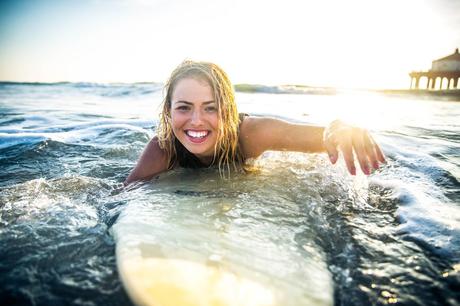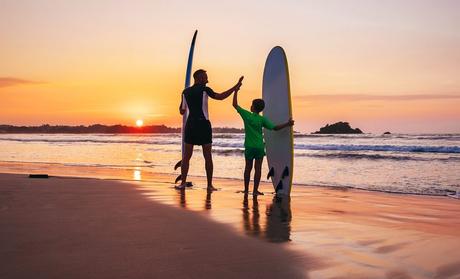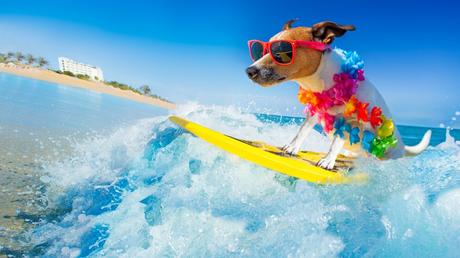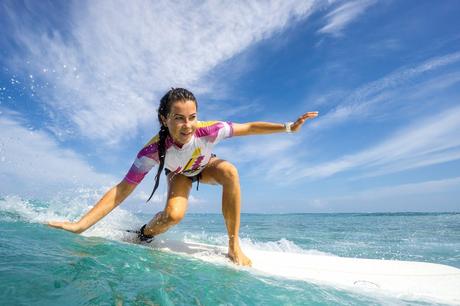Cowabunga, dudes, and bettys! Few sports are as exciting or as popular around the world as that of surfing. For many, it’s a favorite summer activity and the subject of movies and pop culture. For some, surfing can be a way of life. Surfing itself, though, is easier said than done.
Those who are only starting on the board, though, may find that it’s harder than it looks. Surfing’s not all about looking cool or doing cool stunts. It is an intense sport that needs practice, the right board and learning how to read the waves. If that sounds hard, then here are a few great tips for getting started on surfing.

1. Get a Good Teacher
If you want to learn how to surf, then find someone good enough to teach you. Look for teachers that have gotten positive reviews and show they have the experience to back up them up. Then, listen to what they have to say.
2. Start with The Biggest Board Possible
Before doing anything, it is essential to pick out a board. Unless you have experience with board sports, then it is necessary to learn how to balance. The boards that veteran surfers use will be too small and sleek for beginners. They will fall before they know it.
A bigger board will provide a greater area to learn how to balance on, making it less likely for someone to fall off. The bigger the board, the less likely a wipeout will end up being in the long run.
3. Go With a Soft-Top Board
Some of the biggest surfboards that beginners can find are soft-top boards. That is surfboards that use materials that are soft and comfortable, like foam. The surfboards used by pros use hard plastic, so someone not used to that is going to find it’s a pain on their legs and butt.
There is another reason why beginners should use soft-top boards at first. When they end up wiping out on a wave, that surfboard could end up flying in the air and into their face. Getting hit in any part of the body by a hard plastic surfboard can hurt, a lot. Until they get the hang of being on the board, surfers should avoid that scenario as much as possible.
4. Always Wear the Leash
Surfboards usually come with a leash that’s meant to attach to the arm or ankle. No matter how good a surfer may get, its good practice to keep it on at all times. It may be a pain at times, but it could end up saving your life.
When a wipeout occurs, a surfer will get separated from their board, which can be the one thing keeping them safe. When that happens, they may only have a short amount of time to find their board before they get exhausted. The leash will keep surfers attached to their board, letting them get back on board and keeping them safe.
5. Never Surf Alone

This tip is twofold. When learning how to surf, the best thing you can do is to determine in a group. First, doing things with a group of like-minded people that you know can make the experience more enjoyable. Second, and most important, is having people around who can help you. This way, you will not be as likely to injure yourself learning how to surf or get into dangerous situations.
6. Keep Your Eye on What’s in the Water
Surfers need to be mindful of what is around them in the water and on the shore. If they’re not careful, they could end up running into rocks jutting out of the water or other kinds of debris. A collision can lead to serious injury, so that cannot happen.
Then there’s what’s living in the water itself, and they could perceive surfers as enemies. Stingrays can become aggressive when they feel they’re cornered. While Sharks do not attack people as much as Jaws portrays them, they are still a threat. It’s said that sharks can mistake the shape of a surfboard for a prey animal, which leads them to attack. Last but not least, be mindful of any other sea creatures near you in the water and give them a wide berth.
7. Start Somewhere With Fewer People
It will be tempting to go to the most popular surfing spots in the area. Odds are, though, they will be claimed by more experienced surfers who call dibs on the best waves. Going somewhere that doesn’t have as many people around is ideal in this case. Rookie surfers will get more wave time, and thus more time to rack up the experience for themselves. Remember to bring a few people, though, to watch your back and be there to bail you out if there’s any trouble.
8. Stretch it Out on the Beach
Before jumping right into the water, take some time on the beach to do some stretching to loosen up the muscles.
9. Do a Last-Minute Check

Make sure that everything is in place and doesn’t show any signs of damage. That could end up saving your life in the worst case scenario.
10. Watch the Water
To master the art of surfing, one must understand the waves where they wish to surf. To do that, find out when they will begin to break and how they do so. Watch the other surfers and see what they will do, and then try and adopt those methods. Remember to do this every time before going into the water, even after surfing for years.
11. Practice Paddling
When not riding a wave, the primary way a surfer moves in the water is by paddling. When out on the water for extended periods, that can be exhausting. The solution to this, though, is simple: practice. Take some time to find the best paddling rhythm. Then, practice it until your body gets used to the repetition.
12. Find the Paddling Sweet Spot
A common mistake that rookie surfers can make is paddling from the wrong place on their boards. Too far back, they won’t be able to move now and waste energy. Too far forward, they’ll cause the board to dip into the water. That’s bad. So, look for the best place to paddle on a surfboard, then commit it to memory.
13. Master Prone Position
Learn how to lay still on the surfboard while maintaining balance at all times. First, practice it on the beach until you’ve gotten comfortable with it. Find the spot where you think you’ll be least likely to fall off. Then, once you feel you’re ready, head into the water and practice it in the moving water.
14. Master the Pop-Up
Once you’ve mastered the prone position, the next step is the pop-up. Pop-up is where a surfer moves as fast as they can from being prone to upright and ready to surf. As before, practice it on the beach before doing it on the water. Great surfers should be able to do it through muscle memory eventually.
15. Get Comfortable Sitting

Surfboard’s arent’ the comfiest of places to sit, so find the best way that you like to sit on it. The two primary forms of sitting are with the legs out of the water or dangle them over the side. This method may be more comfortable, but passing sea creatures may take notice. Predators may mistake leg movement for something to eat.
16. Start Small
Don’t go after the biggest wave you can find off the bat. That’s an excellent way to get thrown off. Instead, work with waves that are only a few feet high, get a feeling for them, and then master them. Don’t move on to the big waves until your mentor thinks you’re ready. If they say you’re not, then you’re not ready yet.
17. Avoid the Big Boys
While you’re still learning how to surf, avoid tangling with the big dogs out there. That means staying away from the places where the veterans are out surfing. They will potentially have years of experience under their belt and know what they’re doing.
If a rookie were to try to surf a big wave, then they face a higher risk of wiping out and injuring themselves. Just as bad, they can end up getting in the way of other people, leading them to get into trouble.
18. Bend Your Legs, Not Your Back
When getting up into the surfing position, do not bend with your back. Focus on bending at your knees instead. Bending at the knees will provide more balance than it will with the end. Plus, turning the back is a giveaway that you don’t know what you’re doing.
19. Get Used to Wipeouts
No matter how much you try and avoid it, it’s a simple fact: sooner or later, wipeouts will occur. It’s better to get used to them while still in safe conditions than while riding giant waves.
20. Learn How to Wipeout Properly

When wipeouts do end up occurring, there’s a correct way of doing them. That is, there’s a way to avoid most injuries. There are a few things that one should do when they know that they’re going to wipe out.
First, get away from the surfboard. Jumping in front of the board may lead to it hitting your head, leading to a concussion. Avoid that at all costs.
Instead, try and position yourself so that you get in the water butt-first. Make sure to keep your head protected from damage. Try your best to avoid panicking. Panicking will only make things worse and make you use up energy and air.
Resist the temptation to head up right away. The wave may still be above you, causing you to get thrown back down. Try and wait for the tide to pass before coming up for air. Once up, find your surfboard, then get back on it. After that, decide if it’s safe to continue or if you should head for shore. This is where keeping the surfboard leash comes into play: it will save a surfer’s life in some cases.
21. Stay Perpendicular to Whitewater
Make sure that you are perpendicular to the whitewater, the part of the wave that’s breaking in on itself. If you don’t do that, then the force of the wave will pull surfers under, and they will get dragged to the shore.
22. Remember to Have Fun!
If someone isn’t having fun doing something that should be fun, then it’s not for them. In other words, make sure that you have fun surfing!

